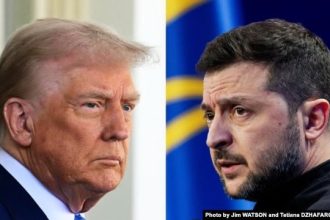North Korea is reportedly preparing to significantly expand its military presence in support of Russia’s campaign in Ukraine, with up to 30,000 troops potentially being deployed to reinforce Moscow’s forces on the front lines, according to a Ukrainian intelligence assessment obtained by CNN.
This projected deployment follows the covert dispatch of 11,000 North Korean troops in late 2024, who were instrumental in helping Russia repel Ukrainian advances in the Kursk region.
Despite the heavy toll, around 4,000 casualties, North Korea’s partnership with Russia has only deepened.
Ukraine’s defense intelligence agency, which provided the assessment, indicates that Russia’s Ministry of Defense is ready to supply the North Korean soldiers with the necessary arms, ammunition, and equipment.
The document notes there is “a great possibility” that these troops will be drawn into direct combat within Russian-occupied territories of Ukraine to “strengthen the Russian contingent, including during the large-scale offensive operations.”
With plans underway, satellite imagery obtained by CNN reveals key signs of preparation, including the arrival of a known deployment vessel at a Russian port and cargo aircraft movements at North Korea’s Sunan airport.
The same routes, both maritime and aerial, were used during previous deployments.
“Despite the heavy toll, around 4,000 casualties, North Korea’s partnership with Russia has only deepened.,” said Joe Byrne, a senior analyst at the UK-based Open Source Centre. “This appears to indicate the routes previously used to move DPRK troops are active, and could be used in any large-scale future transfer of personnel.”
North Korea’s original troop movement occurred under a veil of secrecy, only publicly confirmed by Russian President Vladimir Putin in April 2025.
Imagery from October 2024 showed North Korean soldiers receiving gear at Sergeevka military base in Russia’s Primorskyi Krai.
One month later, analysts observed a Ropucha-class Russian ship, capable of carrying 400 troops, docked at Dunai port, a key indicator of personnel transfer.
That same class of vessel reappeared at the Dunai port on May 18 this year, according to satellite evidence provided by the Open Source Centre. Aircraft believed to be Ilyushin Il-76 cargo planes were also seen taxiing at Sunan airport in June, echoing last year’s deployment pattern.
Senior fellow and director of the Korean program at the Stimson Center, Jenny Town said, while the projected number of 30,000 troops seems “high… but they can certainly come up with that number. They won’t be elite soldiers. Kim Jong Un has said he is all in, so it depends on what Russia has asked for.”
Town estimates a staggered deployment of 10,000 to 20,000 troops as more plausible. “There have been rumors that Russian generals have been inside North Korea training troops there already,” she added.
Ukraine’s Defense Minister Rustem Umerov expressed concern over the risks Kim Jong Un may be taking.
“Russia’s use of elite North Korean troops demonstrates not only a growing reliance on totalitarian regimes but also serious problems with its mobilization reserve,” he said. “Together with our partners, we are monitoring these threats and will respond accordingly.”
On Friday, Ukrainian military chief Oleksandr Syrskyi warned that Russia was concentrating 110,000 troops near Pokrovsk, signaling a possible upcoming offensive on this strategic town.
Meanwhile, Sergei Shoigu, Putin’s longtime adviser and former defense minister, traveled to Pyongyang on June 17, his second trip in two weeks, on a direct order from the Kremlin
. TASS, the Russian state media outlet, reported that during the visit, Shoigu revealed plans to dispatch 1,000 North Korean sappers and 5,000 military construction workers to Russia for mine clearance and infrastructure restoration in the war-torn Kursk region.
South Korea’s National Intelligence Service also believes deployment preparations are ongoing. According to lawmaker Lee Seong-kweun, the agency has briefed legislators that North Korea is actively selecting troops for overseas duty, with deployments potentially beginning as early as July or August.
Lee also mentioned Russia’s public confirmation of another 6,000 North Korean construction and mine-clearing personnel being readied for the front.
Satellite images from Maxar Technologies captured on April 15, 2025, show what analysts believe is an expanded Russian-North Korean military base in Postoyalye Dvory, located just 10 kilometers from the city of Kursk.
Further insight came from a video shared on Telegram by Russian presenter and politician Marina Kim, showing extensive preparations at a North Korean unit’s encampment and dugout systems in the area.
A Russian trainer featured in the video said, “As fighters they are not worse than ours. The enemy runs away first,” and highlighted that North Korean recruits, aged 23 to 27, were “physically well-prepared.” During her visit, Kim also examined a translation guide for basic Russian military terms in Korean.
The footage, which includes scenes of North Koreans living in fortified trenches adorned with Korean-language motivational posters and cultural items, does not clarify if these are newly arrived troops or veterans of last year’s deployment.
Other footage released by TASS underscores a growing level of integration between the two forces, with North Korean soldiers seen participating in joint building-clearance drills and receiving shotgun training—a tactic used against Ukrainian drones.
Kim Jong Un’s increasing alignment with Moscow appears strategic, with CNN reporting that the North Korean leader inspected special forces units on May 14—potentially linked to the anticipated troop deployment.
In addition to ground forces, North Korea’s material support for Russia has become increasingly clear. Ukrainian officials have recorded at least 82 North Korean KN-23 and KN-24 missile strikes, including one that killed 11 civilians in Pokrovsk in January 2024. February saw a surge in their use.
CNN has also reviewed Russian-language training manuals for North Korean artillery units, indicating deeper interoperability between the two militaries. These documents surfaced amid a wave of online videos showing North Korean artillery in action along the front.
A recent UN report, backed by 11 member states, concluded that Pyongyang had sent over 100 ballistic missiles and 9 million artillery shells to Russia in 2024 alone. South Korean military officials corroborated this, noting that an additional 3,000 North Korean troops were deployed earlier in the year.
Town believes Pyongyang sees strategic value in its support of Moscow. “The more ‘blood debt’ there is between them,” she said, “the more North Korea will benefit in the long run, even if they are making sacrifices in the short term.”







